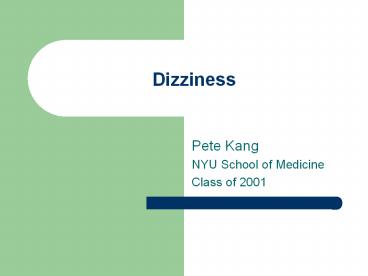Dizziness PowerPoint PPT Presentation
Title: Dizziness
1
Dizziness
- Pete Kang
- NYU School of Medicine
- Class of 2001
2
Dizziness epidemiology
- 1.5 of all hospital admissions
- 26 of all ED pts stated that they had
experienced dizziness - Most common non-pain-related complaint in the ED
- Account for 8 million outpatient visits per year
in the U.S. - Adult gt Pediatric
3
Dizziness differential diagnosisbroad
categories of diseases
- Vertigo
- Near-faint or Presyncope dizziness
- Psychophysiologic dizziness
- Hypoglycemic dizziness
- Disequilibrium
- Drug-induced dizziness
4
Vertigo subclasses
- Acute spontaneous attack
- Recurrent spontaneous attacks
- Recurrent episodes of positional vertigo
5
Acute spontaneous attack of vertigo
- Unilateral loss of vestibular function
- Clinical presentation
- Intense sense of rotation aggravated by head
motion - World turns slowly toward intact side, then
quickly toward affected side - Prefers to sit upright w/ head still or to lie w/
intact side undermost - Difficulty in standing/walking may fall toward
affected side - May have nausea/vomiting, malaise, pallor,
diarrhea
6
Peripheral vs. Central lesions
- Peripheral
- Severe nausea/vomiting
- Mild imbalance
- Hearing loss common
- Mild oscillopsia
- No focal signs
- Rapid compensation
- Central
- Mod. nausea/vomiting
- Severe imbalance
- Hearing loss rare
- Severe oscillopsia
- Focal signs
- Slow compensation
7
Viral neurolabyrinthitis
- Most common gt90 of cases in younger age group
w/o major vascular risk factors - Subacute onset URI 2 weeks prior
- Unilateral caloric paresis, /- hearing loss
- No other focal signs
- Symptomatic management, vestibular rehabilitation
8
Bacterial otomastoiditis w/ labyrinth involvement
- Prior infection bony erosion seen in CT
- Possible cholesteatoma
- Possible complication of bacterial meningitis
- Antibiotics
- Surgical debridement
9
Cerebellar infarct/hemorrhage
- Elderly, w/ vascular risk factors
- Other focal neurological signs present usually
10
Multiple sclerosis
- Vertigo is the presenting symptom in 5 of
patients w/ MS - Multifocal neurologic symptoms/signs
- Characteristic T2-intense lesions in white matter
on MRI
11
Recurrent, spontaneous attacks of vertigo
- Sudden, temporary, and large reversible
impairment of resting neural activity in one
labyrinth or its central connections - Lasts from minutes to hours
- Restoration of normal neural activity, rather
than compensation
12
Menieres disease
- Characteristic fluctuating low-frequency hearing
loss - Episodic vertigo
- Roaring tinnitus
- Ear pressure
13
Autoimmune inner ear disease
- May mimic Menieres disease
- Signs/symptoms of systemic involvement
- Elevated ESR, positive ANAs/rheumatoid factor
- Immunosuppression
14
Syphilitic labyrinthitis
- Similar to Menieres disease in signs/symptoms
- Positive VDRL and/or FTA-ABS
- Penicillin, steroids
15
Migraine
- Vertigo occurs in approximately 25 of migraine
patients - Hearing loss infrequent
- Headaches that meet International Headache
Society criteria for migraine - Treat migraine
16
Vertebrobasilar TIA
- Common cause in older patients w/ risk factors
- Subclavian steal syndrome
- Abrupt, last several minutes
- Other sxs of posterior circulation
- Antiplatelet drugs, anticoagulation
17
Recurrent, positional vertigo
- Transient excitation within the vestibular
pathways triggered by change in position - Central vs. Peripheral lesions
18
Recurrent, positional vertigo peripheral vs.
central
- Peripheral
- Torsional/horizontal
- Latency
- Brief
- Fatigability
- Debris moving in semicircular canal
- Central
- Pure vertical
- No latency
- Persistent
- No fatigability
- Damage to central vestibulo-ocular pathways
- Brainstem or cerebellum
19
Benign positional vertigo (BPV)
- Dix-Hallpike test
- 2-10 sec latency
- Torsional/horizontal nystagmus
- Lasts lt 30 sec (fatigability)
- Any deviation from this must raise suspicion for
a central lesion
20
Recurrent, positional vertigo central lesions
- Multiple sclerosis
- Cerebellar tumors
- Medulloblastomas
- Cerebellar atrophy
- Chiari type I malformation
21
Near-faint dizziness or presyncope
- Light-headedness before losing consciousness or
fainting - Reduced blood flow to the entire brain
- Causes
- Vasovagal
- Orthostatic hypotension
- Volume depletion
- Cardiac arrhythmias, cardiomyopathy, constrictive
pericarditis, aortic stenosis
22
Psychophysiologic dizziness
- Associated with panic disorder (lifetime
prevalence of 1.6) - Hyperventilation ? reduce pCO2 ? cerebral
vasoconstriction ? decreased cerebral blood flow - Onset with specific situations (such as public
places, driving in highways, etc.)
23
Hypoglycemic dizziness
- Complication of insulin/sulfonylurea treatment
- Insulinoma
- Fasting
- Postprandial phenomenon (functional hypoglycemia)
24
Disequilibrium
- Sensation of losing ones balance without feeling
of illusionary movement or impending LOC - Unsteadiness standing, walking
- Disruption in integration between sensory inputs
and motor outputs - Associated with aging
25
Drug-induced dizziness
- Aminoglycosides, cisplatin
- Vertigo, disequilibrium
- Damage to vestibular hair cells
- Antiepileptic
- Carbamazepine, pheytoin, primidone
- Disequilibrium, intoxication
- Tranquilizers
- Barbiturates, benzodiazepines, tricyclics
- Intoxication
26
Drug-induced dizziness
- Antihypertensives/diuretics
- presyncope
- Alcohol
- Intoxication ? CNS depression
- Disequilibrium ? cerebellar toxicity
- Positional vertigo ? change in cupula specific
gravity
27
Treatment medical
- Best therapy treating the underlying disease
- Indication for symptomatic therapy
- Illness is not readily treatable
- Treatment must be continued for a long period
before improvement - Severe and prolonged vertigo
28
Treatment medical
- Acute severe vertigo
- Promethazine (antihistamine) sedative (),
antiemetic () - Diazepam sedative (), antiemetic ()
- Nausea vomiting
- Prochlorperazine (phenothiazine)
- Metoclopramide (benzamide)
- Chronic recurrent vertigo
- Meclizine (antihistamine)
- Dimenhydrinate (antihistamine)
29
Treatment surgical
- Conservative surgery
- Shunt surgery (decompress endolymphatic sac)
- Effective in 75 of cases
- Selective section of vestibular division of CN
VIII - Effective in gt90 of cases
- lt10 significant hearing loss
- Abnormal vascular loop at the brainstem insertion
of CN VIII
30
Treatment surgical
- Destructive surgery
- Labyrinthectomy
- Complete destruction of the end organ
- Extremely high cure rate
- Cost destruction of all hearing in the involved
ear
31
Vestibular rehabilitation
- Process of compensation
- Requires
- Intact vision depth perception
- Normal proprioception
- Intact sensation in lower limbs
- Graded increase in demand for central
compensation of vestibular input

